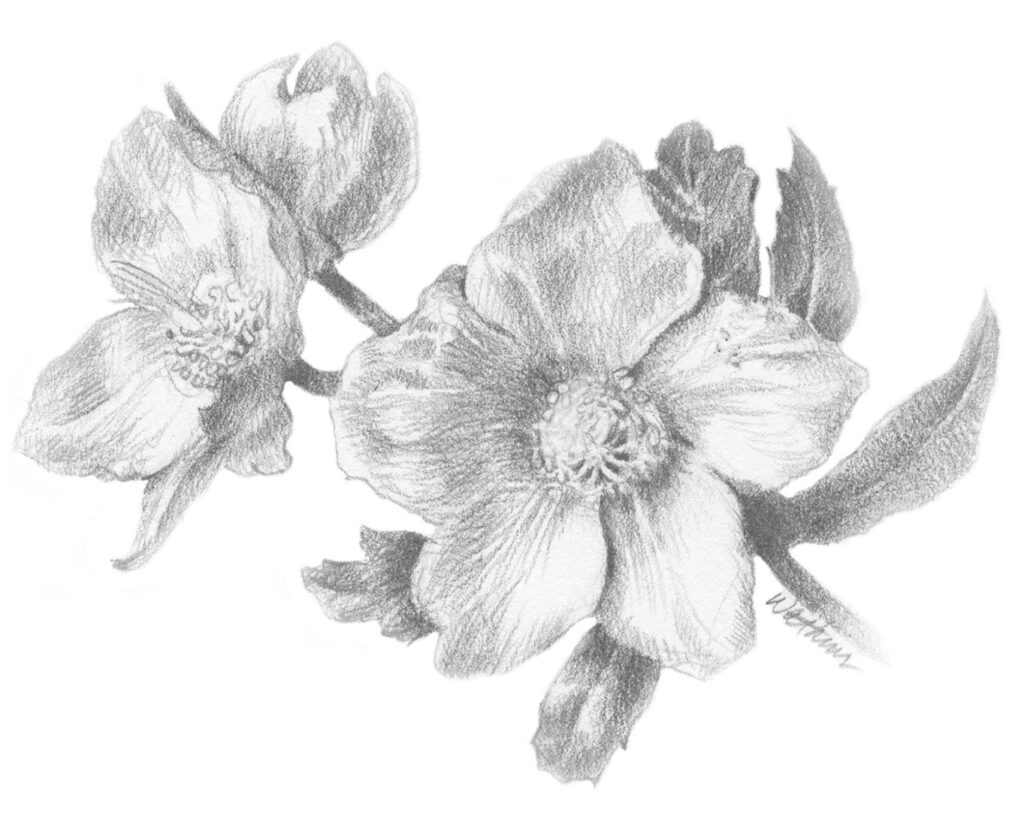February, Hellebores
Through the Garden Gate
By Leslie Watkins

It’s winter. There’s a blanket of snow on the ground, and everything is frozen. Yet, as if to prove that there is always hope, always beauty, always something wonderful and amazing, hidden under the snow are the blossoms of hellebores. Like a precious, silent secret that we dare not reveal in order to protect and preserve, the Christmas rose blooms. Its flowers and buds are nestled down into thick, leathery evergreen leaves. A miracle in snowy white perfection, hellebores dare to flower while other plants have died back to dormant roots underground and seeds lay waiting for longer and warmer days to germinate.
In contrast to their delicate, white translucent petals, Helleborus niger, or black hellebores, are tough plants (“niger” refers to the roots, which are black). They are perennials reliably hardy in zones 3-8. They’re easy to care for and make beautiful and long-lasting vase flowers. They’ll tolerate shade and look gorgeous as a ground cover in light-dappled woods combined with Christmas ferns, another tough evergreen perennial. The two plants together would make a lovely bouquet to grace holiday table settings. The flowers measure about three inches in diameter and bloom throughout winter into March. Also available at the nursery are the Lenten roses, Helleborus orientalis, lovely plants that are available in an array of colors: rose, pink, mauve, violet, lime green and everything in between. They can be streaked, spotted and speckled and start blooming when the Christmas roses stop. Hybridizers have been very busy with these plants, and there are now many varieties to chose from. All hellebores grow well in neutral to alkaline soils.
Late winter is a great time to prune your fruit trees. Bare branches allow you to see the structure better to shape it better. The wounds will heal quickly when spring arrives and before insects have a chance to hatch out. With fewer branches, the tree will send its reserved energy into the fewer remaining branches, which will be more productive and bear larger fruit.
Start by removing dead, diseased and damaged wood, any crossed branches, vertically growing water sprouts and suckers from the trunk. Next, prune to open up the tree form to sunlight and air. This will help to discourage pest, mold and disease problems. Make your cuts clean and close to the branch or trunk, without leaving stubs. Finally “head back,” which means to shape the tree and shorten branches that are too long and thin. You want the branches to grow shorter and thicker to be able to support the weight of the fruit without bending too much and possibly snapping. You’ll be able to direct future growth by selecting which buds to end with. Cut about a quarter inch past the last bud for the tree to heal. Good tools include a hand saw, sharp shears and clippers. Wipe them frequently with isopropyl alcohol to prevent speeding diseases from tree to tree and dispose of your cuttings in the burn pile.
Fruits for Winter Pruning
- Apple
- Pear
- Crabapple
- Quince
- Medlar
Fruits for Summer Pruning
- Peach
- Cherry
- Apricot
- Mulberry
- Damson Plum
